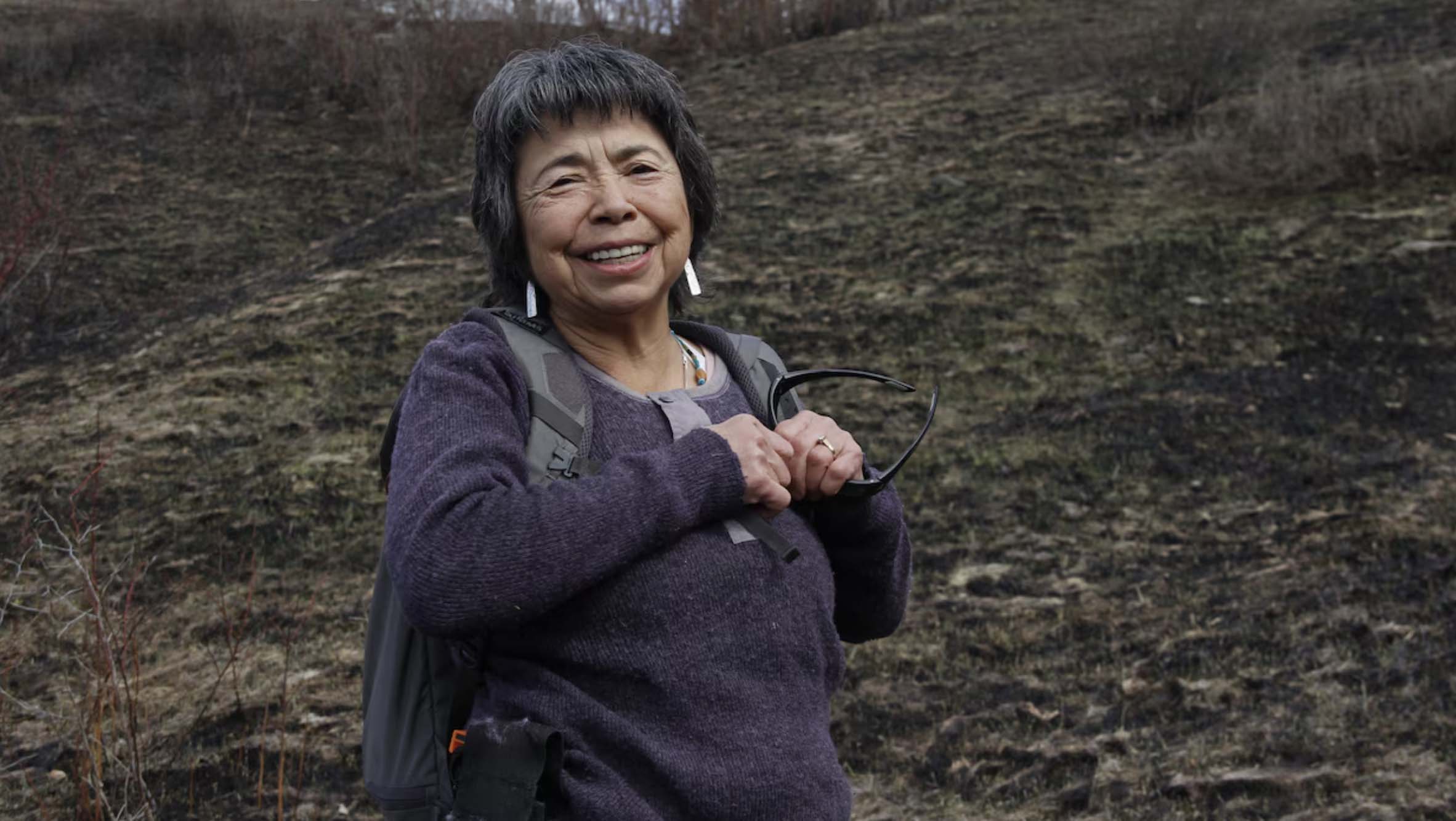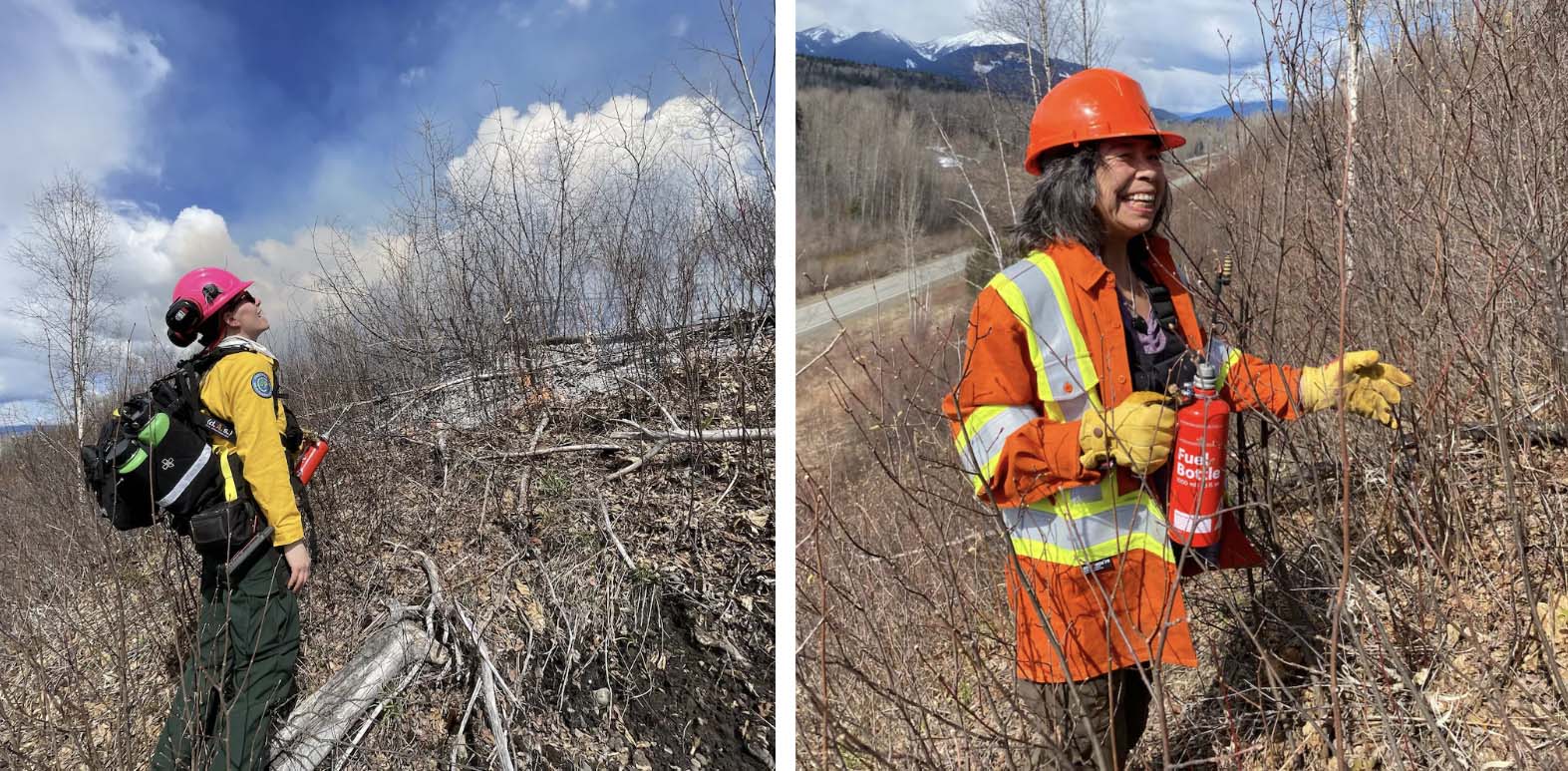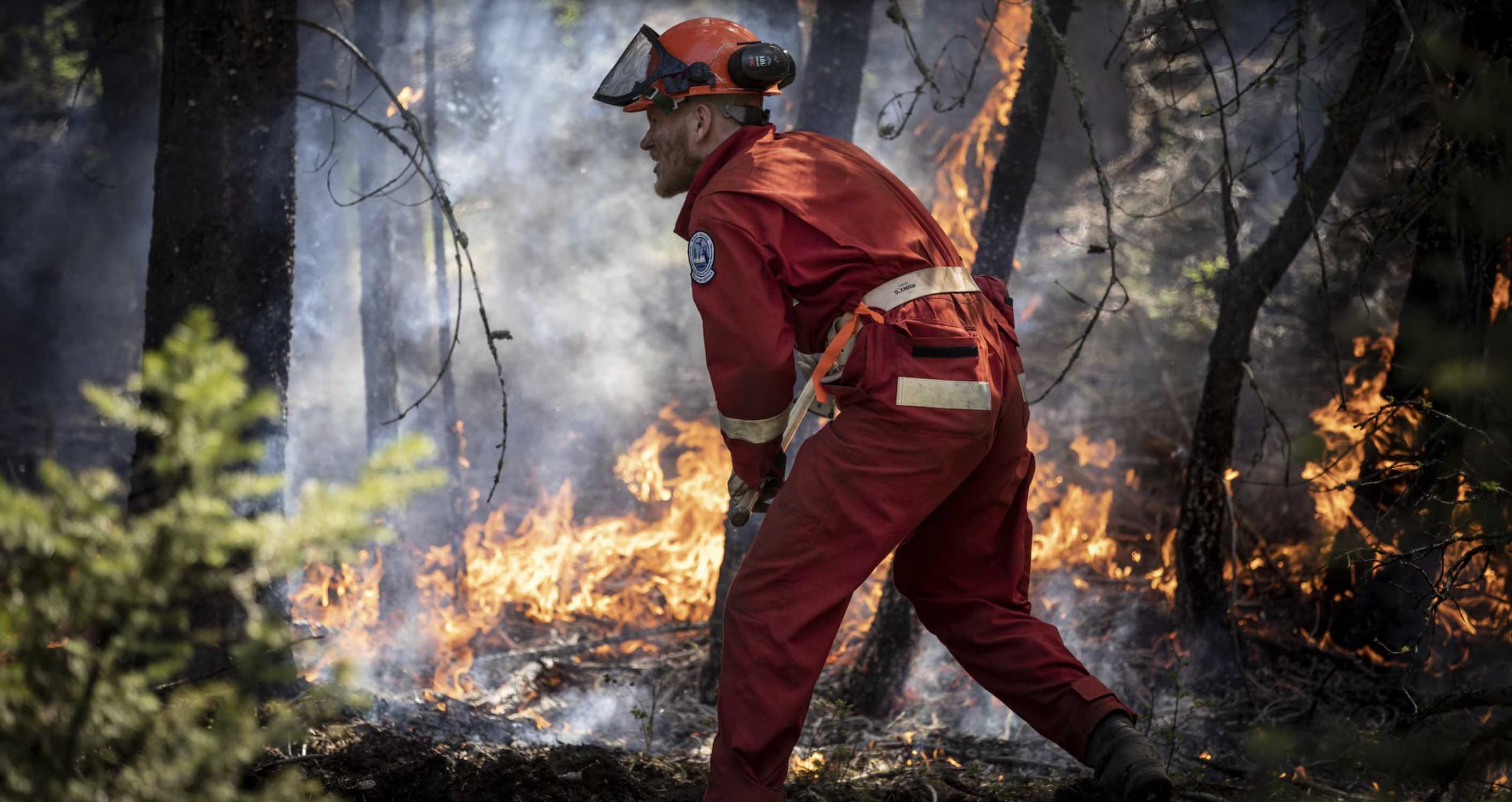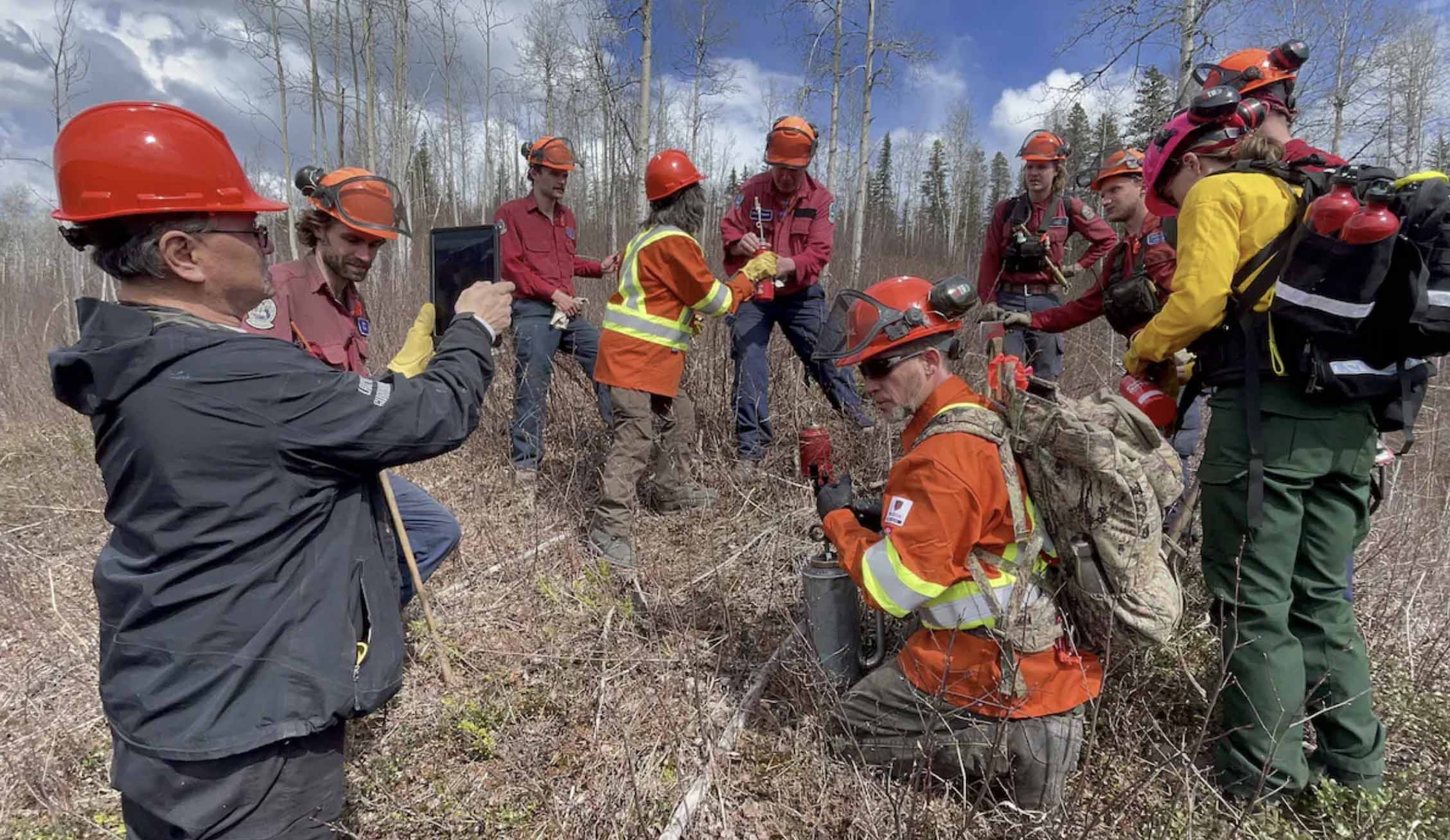It’s like Christmas Day for Darlene Vegh. This elder from the Gitanyow First Nation finds something in the forest that would go unnoticed by unobservant hikers. Darlene says she can’t see very well anymore, and yet she notices the hair of a spirit bear – a rare species of black bear with white fur – caught in the branches of a tree, the tracks of a moose, the tiny shoots of blueberries, and even traces of her ancestors.
“Here, it’s the pit of an old house, and here, a kind of refrigerator that the ancestors used,” she says, with a smile on her lips, a bear repellent strapped to her waist.
If this kind of thing is visible today, it is because in 2023, and just a few weeks ago, she participated in the first traditional burnings in the Lax’yip (territory) of Gitanyow, a Gitxsan community located in northern British Columbia.
She was accompanied by Guardians of the Gitxsan territory, firefighters from BC Wildfire (the British Columbia Wildland Fire Department) and experts. After the flames, everything that was buried under a mass of brush or shrubs appears to her eyes.

Lost Practice
Cultural fires are an ancient practice of many Indigenous peoples. They made it possible to maintain the forest, regenerate it, support biodiversity and give space to small shoots like huckleberries. Their benefits extend to preventing large forest fires, like those that have been wreaking destruction in the province in recent years.
However, the activity was banned by colonizing governments in the 20th century, sometimes even under penalty of imprisonment or death.
Today, it is quite a task to resurrect this practice, because Indigenous people face a certain mistrust from governments, who believe that their knowledge is limited.
“The fight against traditional burning has existed for around 130 years. Since then, the health of the territories has deteriorated and is accelerating, because of climate change,” says Darlene.
Today, the federal government allocated a budget of $263,000 to Gitanyow for the community to revive this practice, in collaboration with BC Wildfire.
“We Are The Fire”
Darlene, part of the Wilp (house) Wii Litsxw, has been fighting for this for 30 years. Raised in a white family, she quickly returned to live in the woods to reconnect with her roots.
“I learned everything from my ancestors,” says the 68-year-old woman who spent years surveying the Lax’yip and documenting herself.
For this project to reintroduce cultural burning, Darlene even came out of retirement, “for huckleberries, for our food security, for grizzly bears, for the creation of better habitat for moose. And all thanks to fire.”
Kevin Koch, wildlife biologist and manager of the Land Guardian Program, explains, “Huckleberries need light and a relatively open canopy. Historically, Indigenous people [did cultural burning] by not killing all the plants.”
“We are the fire, but not the fire of the oil industry. We are the fire of the earth, and that means good fire”, says Darlene.
Darlene has an unconditional love for these small fruits, which are part of the staple food of the Gitxsan people. For nearly 40 years, she mapped ancestral burning areas. These large plots were decimated by more recent wildfires, and nothing will grow there for 100 years or more, she predicts.
“Whereas if we manage to control fires every 7 to 10 years, the earth will become healthy again. This is our goal,” she explains.
The idea is to undo the harm that has been done to the forests. Tara Marsden (Naxginkw), an independent Indigenous consultant who works for Gitanyow, explains that for a long time, feared fires were put out very quickly.
“They were also extinguished quickly to protect the forestry industry, which did not want to see its profits go up in smoke,” she adds.
Below the slope that Darlene and the whole team burned, a large truck carrying tons of logs zooms past. At the sight of him, Darlene’s heart breaks for a second.
But suddenly, she lets out a little cry, bends down and shows the beginnings of a small huckleberry plant. She observes the buds, smiles. Seeing the blueberries bloom more than expected again is the dream of her life.
Fire In The Service Of Forest
But how can cultural burning help them? First, they are less hot than huge forest fires, and therefore do not burn the rhizomes – the root system of plants – and the fungi, which act in symbiosis with the plant.
Fire temperature is essential in the practice of cultural burning.
“We also want to keep as much carbon as possible in the soil instead of seeing it go up in smoke. If you control the temperature and a certain level of oxygen, you create carbon and it can stay in the soil for a long time,” explains Darlene.
“Huckleberries also need the combination of ashes from fires and rain to produce sweeter, larger and better quality fruits,” she adds, taking out her tablet.
Because Darlene doesn’t want to lose a single bit of her discoveries. On a map, she points out each of her observations to keep track of them.
And it’s not just huckleberries that should be able to grow on these scorched lands. The first stalks of spring onions have emerged from the ground. There are also nettles and lillies that could come back.

A Long And Difficult Process
Burning areas are determined in consultation with the eight hereditary chiefs of Gitanyow. They are the ones who manage everything that affects the territory, independently of the band council.
Then, many factors must come together to carry out a cultural burn. You need a little wind, but not too much. You need dry weather, but not too much either. These burns must be carried out in spring or fall.
“When it’s 35 degrees in summer and the days are long, the fire continues to burn. Whereas in spring or fall, we have shorter combustion windows. The fire will go out naturally thanks to the temperatures cooler in the evening,” continues Kevin.
“It’s a real challenge. There can be a [auspicious] day every three years,” he says again. You also need adequate equipment, water lances, a tanker truck and a significant number of workers.
Then comes the particularly heavy administrative side, according to the people involved. And that’s where BC Wildfire comes in. The organization recognizes that this region has long been a place where we have experienced fairly frequent wildfires in recent years, explains Morgan Blois, communications officer at BC Wildfire.
A few years ago, she saw a community-produced video that introduced the Land guardian program.
“They [BC Wildfire representatives] asked us if we would like to do a project where they would help us plan fire management,” says Kevin.
The government body sees it as a win-win partnership, “in the sense that we reduce the risk of fire in the surrounding areas of the community, but this practice is led by Indigenous people,” continues Morgan.
The help is valuable, since it allows you to navigate the administrative burdens. For each area, Gitanyow must call them, establish an ordinance and a burn plan.
“I find that they are very supportive, very respectful and really trying to solve problems to navigate their very bureaucratic system,” says Tara.
Morgan explains this by talking about the mission of BC Wildfire, which is to ensure the safety of all.
Making the connection is Kira Hoffman, a fire ecologist and researcher at the University of British Columbia and the Bulkley Valley Research Center. Darlene, for her part, provides them with the cultural context of the plants. Then, the leaders review the plan which is submitted to the government.
Kira explains that she is in favour of letting communities manage everything.
“Seeing Darlene smile is a great indicator of successful cultural burning,” notes Kira.
It is therefore not only a question of measuring the height of the flames and the heat of the fire, but also of understanding how it constitutes an essential element for the health and well-being of the community, she continues.
“It’s a ceremony with the earth,” says Kira.
At the crossroads between Western science and Indigenous knowledge, the woman who also holds a doctorate is making sure to create a bridge. “I try to bring them all together so that everyone is safe and the objectives are achieved,” Kira assures.
The partnership is not without challenges, since there is a lot of trust to be built and the objectives of the indigenous people and those of BC Wildfire must be in agreement.
“We’ve been able to create a very good relationship so far. This type of relationship is about a step-by-step process and making sure we share the same goals,” notes Morgan, who works with other Indigenous communities in the Province.
The question of responsibility is also very important. This is assumed by the British Columbia Fire Department. “No one else has the accreditation to take on this responsibility,” says Kira.
Trust is therefore established little by little. “People are still afraid of fire and there are no laws on how to do cultural burning. There are only a few laws on prescribed fires,” explains Darlene.
She says it took them a year to obtain authorization from the province.
A Logical Choice
How can we explain the provincial government’s change of heart regarding cultural burning?
“It’s only because now they have a vested interest. It’s in the interest of the [provincial] government to finally think that maybe the Indigenous people are right. Fire is good for the earth and scientists are starting to realize it now,” argues Darlene.
And it’s not Kira Hoffman who would say the opposite.
According to the researcher, cultural fires were not politically accepted for a long time, but things are changing quickly.
“People often say that things move very slowly, but I’ve seen things that are only accelerating, regarding the public’s acceptance of fire,” she says, adding in the same breath that there is now a political will to support fire management.
The expert believes that this change was made by force of circumstances. We do not have the choice. Since 2017, British Columbia has become aware of the new reality of wildfires.
“It’s like someone turned on the fire switch and it just wouldn’t go out. So the province recognizes the absolute need to change what we do,” says Kira.
“Many of our best [Indigenous] professionals have not had Western training, so we don’t know their experience and that can be a huge barrier. Yet most of the technical expertise related to fires is held by the communities,” Kira firmly believes.
Darlene even believes that this knowledge “is part of our DNA”.
According to Tara, the resurrection of cultural burning is also a way to prove that Indigenous people are fully capable of managing the territory.
“But above all, it is important for the process of decolonization and recognition of our land management systems, which are valid,” she concludes.
Read the original article by Delphine Jung on CBC Radio Canada website.

